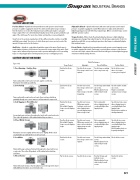Page 529 - CAT4
P. 529
CLUTCH SELECTION
Positive Clutch – Spindle will not turn with motor until operator exerts forward pressure on spindle engaging the clutch. The clutch ratchets when torque resistance from the fastener overcomes the forward pressure and the jaws begin to cam apart. Torque output of the tool is determined by forward pressure from operator and by the cam angle of the clutch jaws. For wood, sheet metal, and machine screws and lag bolts.
Sioux Tools is the exclusive manufacturer of three different positive clutches; Low, Mid and High torque output. Your choice of clutch allows you to more precisely control the amount of torque exerted on the fastener.
Stall Drive – Spindle is coupled directly with the output of the motor. Final torque is reached when resistance of the fastener overcomes the torque output of the motor. Final torque can be influenced by air pressure and/or operator twisting the tool. For prevailing torque or soft pull applications involving machine, wood, or self-tapping screws.
CLUTCH SELECTION GUIDE
1. Free-Running – Sudden Stop
Turns easily until screw head or nut seats against a solid stop. Resistance then builds up suddenly.
2. Soft Pull-Up
Turns easily until screw head or nut seats, then resistance builds up gradually through one or more turns as resilient material compressed.
3. Self-Tapping in Thick Material
Increasing heavy resistance through entire travel until screw head seats. Then either (A) gradual, or (B) sudden final build-up resistance.
4. Sheet Metal Screws
Resistance increases rapidly at first, then eases slightly. At the end, it usually builds up suddenly when screw head seats.
5. Lock Nuts
Starts with heavy resistance that lasts through entire travel until screw or nut seats. Then either (A) gradual, or (B) sudden further build-up resistance.
6. Wood Screws
Starts with small resistance that steadily increases through entire travel with additional resistance as screw head seats.
Adjustable Clutch – Spindle will not turn with motor until operator exerts forward pressure on spindle engaging the clutch. When fastener is tight, clutch will ratchet. Adjusting spring pressure will effect final output torque. Offers consistent torque control with little operator reaction.
Torque Control – Motor shuts off automatically when fastener is tight. Adjusting spring pressure changes final output torque for critical torque requirements. Perfect for applications with little or no prevailing torque where final torque is substantially higher than rundown torque.
Direct Clutch – Spindle will not turn with motor until operator exerts forward pressure on spindle engaging the clutch. Final torque is reached when resistance of the fastener overcomes the torque output of the motor. Excellent stall type tool when tightening group of fasteners without turning off motor.
Fair for all size screws where close torque accuracy is not required.
Good for small to medium size screws.
Requires considerable operator pressure on large screws.
Good for most size screws where stripping torque is considerably higher than tapping torque.
Excellent in non-uniform or misaligned material.
Good for all size screws where stripping torque is considerably higher than tapping torque.
Excellent when sheets are frequently misaligned.
Fair for all size screws.
Excellent for all size screws.
Type of Job
Clutch Performance
Torque Control
Adjustable
Direct/Stall Drive
Positive Clutch
Excellent for all size screws.
Good for all size screws. Close torque control is not required.
Good for large or medium nuts or cap screws only.
Excellent for all size screws.
Good for most screws. Close torque control is not required.
Slow on large screws with long pull-up.
Good for large and medium size screws.
Must be adjusted to run rather slowly for small screws.
Excellent for all size screws.
Not suitable if tapping torque exceeds stripping torque.
Good for most screws. With proper operator technique, can be used where tapping torque exceeds stripping torque. Slow on large screws.
Not recommended unless stripping torque is considerably higher than tapping torque.
Good for all size screws. Not suitable if tapping torque exceeds stripping torque.
Good for most screws. With proper operator tech- nique, can be used where tapping torque exceeds stripping torque.
Not recommended unless stripping torque is considerably higher than tapping torque.
Excellent for all size screws.
Good for most screws. Close torque control is not required.
Good for large and medium screws.
Must be adjusted to run rather slowly for small screws.
Fair for all size screws.
Good for all size screws.
Excellent for large and medium screws.
Must be adjusted to run rather slowly for small screws.
529
POWER TOOLS ASSEMBLY


